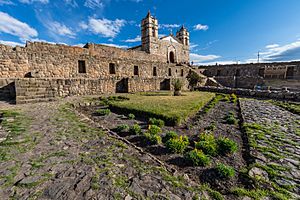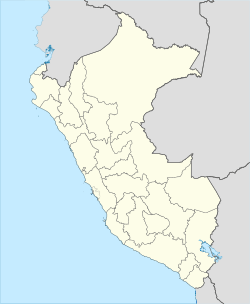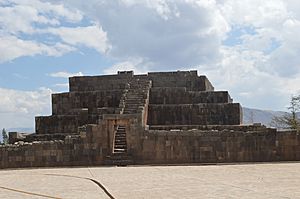Vilcashuamán facts for kids
Quick facts for kids
Vilcashuamán
Willka Waman (Quechua)
|
|
|---|---|
|
Town
|
|

Vilcashuamán Cathedral and the Temple of the Sun
|
|
| Country | Peru |
| Region | Ayacucho |
| Province | Vilcas Huamán |
| Elevation | 3,490 m (11,450 ft) |
Vilcashuamán (pronounced Vil-ka-shwa-man) is a special town in Peru. Its name comes from the Quechua language, meaning "sacred hawk." It is the main town of Vilcas Huamán Province in the Ayacucho region. You can find it high up in the Andes mountains, about 3,490 meters (around 11,450 feet) above sea level. This town is built on an ancient site that was once a very important place for the Inca Empire.
A Look at Inca History
Vilcashuamán was a big administrative center for the Inca Empire. The Incas built it after they took over the lands of the Chancas and the Pocras people. A writer named Pedro Cieza de León wrote that about 40,000 people lived here.
The city was built around a large open area called a plaza. Important ceremonies took place in this plaza. Sometimes, animals like llamas or alpacas were offered as sacrifices. People also poured out chicha, which is a type of corn wine, as an offering.
Two of the most important buildings in the city were located around this plaza. These were the Sun Temple (Templo del Sol) and the Ushnu. Both of these buildings can still be seen today. People believe that the city was shaped like a falcon, with the Ushnu located where the falcon's head would be.
The Ushnu is a special building shaped like a pyramid with a flat top. You enter it through a doorway that has a unique double frame. This type of doorway was used for the most important Inca buildings. On the very top of the Ushnu, there is a large stone with special carvings. This stone is known as the Seat of the Inca (Asiento del Inca). According to Cieza de León, this seat was once covered in shiny gold.
Climate
The climate in Vilcashuamán is typical for its high mountain location. Here is some information about the weather:
| Climate data for Vilcashuamán, elevation 3,518 m (11,542 ft), (1991–2020) | |||||||||||||
|---|---|---|---|---|---|---|---|---|---|---|---|---|---|
| Month | Jan | Feb | Mar | Apr | May | Jun | Jul | Aug | Sep | Oct | Nov | Dec | Year |
| Mean daily maximum °C (°F) | 17.5 (63.5) |
17.5 (63.5) |
17.2 (63.0) |
17.5 (63.5) |
17.8 (64.0) |
17.4 (63.3) |
17.1 (62.8) |
17.7 (63.9) |
17.9 (64.2) |
18.9 (66.0) |
19.5 (67.1) |
18.3 (64.9) |
17.9 (64.1) |
| Mean daily minimum °C (°F) | 5.5 (41.9) |
5.6 (42.1) |
5.6 (42.1) |
4.3 (39.7) |
1.5 (34.7) |
0.5 (32.9) |
0.1 (32.2) |
1.2 (34.2) |
3.0 (37.4) |
3.4 (38.1) |
4.0 (39.2) |
5.2 (41.4) |
3.3 (38.0) |
| Average precipitation mm (inches) | 150.7 (5.93) |
154.7 (6.09) |
120.1 (4.73) |
37.3 (1.47) |
10.9 (0.43) |
5.5 (0.22) |
7.6 (0.30) |
13.5 (0.53) |
21.8 (0.86) |
31.7 (1.25) |
49.8 (1.96) |
102.2 (4.02) |
705.8 (27.79) |
| Source: National Meteorology and Hydrology Service of Peru | |||||||||||||
See also
 In Spanish: Vilcashuamán para niños
In Spanish: Vilcashuamán para niños



